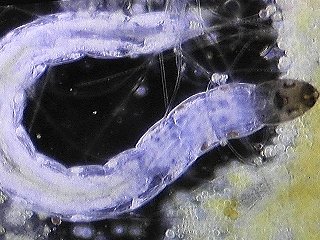Midge larva photographed by Ron Neumeyer

© Ron Neumeyer 1997
MICSCAPE IMAGE OF THE
MONTH - September 1997
Midge larva photographed by Ron
Neumeyer

© Ron Neumeyer 1997
This is an aquatic Dipteran larva, possibly a member of the non-biting midge family, or Chironomidae. It was taken using a Zeiss stereomicroscope equipped with a phototube. The image was recorded on 35 mm slide film by means of a Canon T90 and its dedicated "Macro Ring Light ML-2" flash unit. The head of the ML-2, which has two half-circle flash tubes, is attached to the power pack by a spiral cord. This allows the head to be located up to 25 centimetres from the battery pack, which is mounted to the camera's hot shoe. Like the standard 300TL flash, its output is controlled by sensors inside the camera body.
Ring lights similar to the ML-2 are made by most mainstream camera manufactures. The "donut" shaped light pulse produces shadow free images when mounted on the front of a camera lens. For this picture I placed it about four centimetres below the stage (a glass plate supported by a wood frame on three sides). The circular light pulse illuminated the subject with indirect, transmitted light, producing the darkfield effect. Focusing and positioning of the larva was accomplished with light from the in-base lamp passing through the open centre of the flash head. (At low light intensity the lamp light did not contribute to the final image.)
This technique also works with compound scopes using objectives below NA 0.4 (20x). The procedure is similar if your scope has an in-base lamp. (If not, a little ingenuity should suffice to design some means of positioning the flash head between the mirror and underside of the stage.) First, remove the condenser and carrier to ensure there is nothing between the flash head and stage opening. Next, place the flash head directly onto the light port, facing toward the stage. On the Ortholux, the open centre of the flash head fits nicely around the light port. This allows one to observe and focus the subject by transmitted light. When the subject is ready, trip the shutter to fire the flash. If the head is not too far below the stage (try various heights) the pulse should pass through the slide at a very oblique angle. Under these conditions only light refracted, or reflected by the subject enters the objective's front element, the remainder misses the lens resulting in a dark background, referred to as darkfield (or darkground in older texts). As long as the microscope lamp is not too bright, it will not affect the image.
***************************************
Ron
Neumeyer,
CLOSE-UP IMAGING - Small object photography
11135 Kendale Way,
North Delta,
BC - CANADA
V4C 3P7 (604-582-2552)
***************************************
Editor's note: Coincidentally as the September
1997 Micscape went on-line, a fascinating article on midge larvae
'The Buzz on Climate' was published in New Scientist, 13
September 1997, p. 25. Apparently midge larvae are proving to be
very sensitive indicators of climate change, surpassing
indicators such as ice cores, pollen data and tree rings. Each
midge species only lives in a very narrow temperature range,
therefore the relative abundance of different species in lake and
bog sediments can provide valuable information on climate
changes.
Please report any Web problems
or offer general comments to the Micscape Editor,
via the contact on current Micscape Index.
Micscape is the on-line monthly
magazine of the Microscopy UK web
site at Microscopy-UK